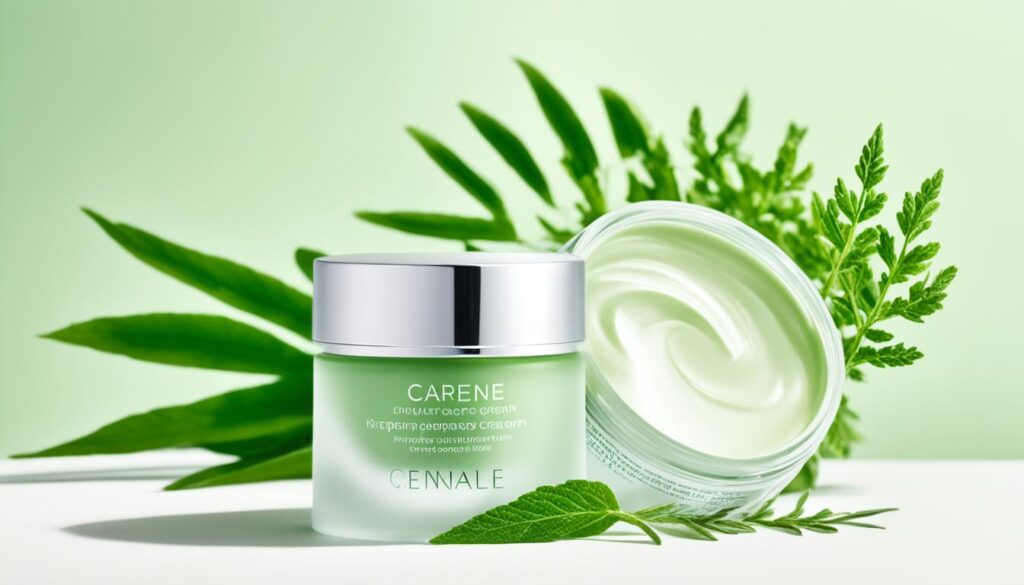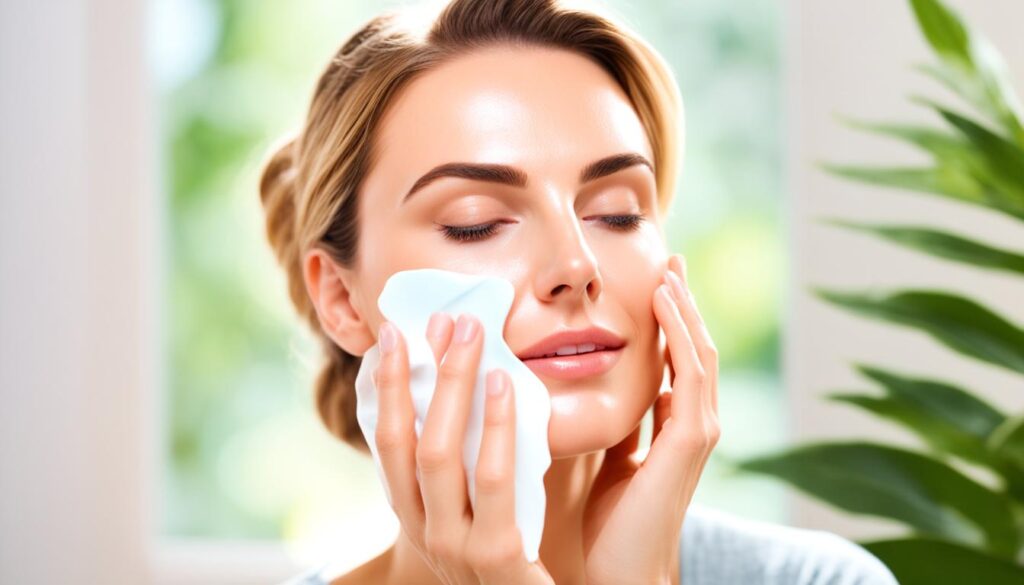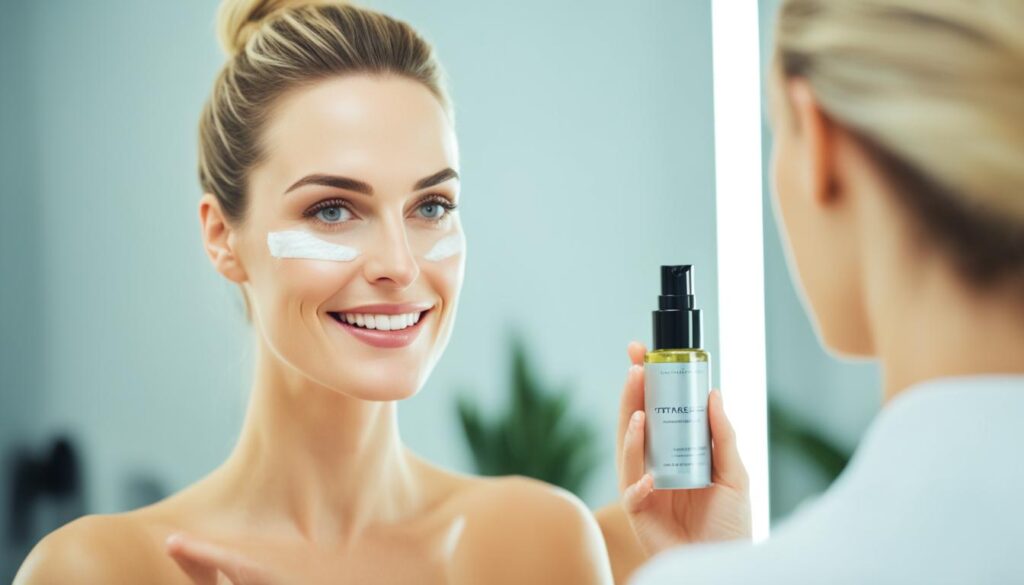Effective Skincare Routine For Combination Oily Skin

Combination oily skin requires a targeted skincare routine that addresses both the oily and dry areas of the face. This type of skin can be challenging to manage, as it requires finding the right balance between hydration and oil control. With the right products and proper care, you can achieve a balanced complexion and maintain healthy-looking skin.
In this article, we will guide you through an effective skincare routine specifically designed for combination oily skin. We will cover cleansing, treating, moisturizing, and protecting your skin. By following these steps and incorporating the recommended skincare products, you can achieve a healthy and radiant complexion.
Let’s dive into the details of an ideal skincare routine for combination oily skin.
Key Takeaways:
- Combination oily skin requires a balanced skincare routine that addresses the specific needs of both oily and dry areas.
- Cleansing, treating, moisturizing, and protecting are the key steps in an effective skincare routine for combination oily skin.
- Choose skincare products with ingredients like salicylic acid, hyaluronic acid, niacinamide, and ceramides for optimal results.
- Adapt your skincare routine as needed to suit the changing needs of your skin.
- Consistency is key to achieving and maintaining a healthy and radiant complexion.
Cleansing for Combination Oily Skin
The first step in a skincare routine for combination oily skin is cleansing. Effective cleansing is crucial to remove excess oil, impurities, and makeup while maintaining the skin’s natural balance. For combination skin, it’s essential to find a cleanser that addresses both the oily and dry areas of the face.
A salicylic acid cleanser is particularly beneficial for combination oily skin. Salicylic acid has powerful exfoliating properties that help unclog pores, reduce oiliness, and prevent breakouts. It provides gentle exfoliation to soften and smooth the skin, leaving it looking refreshed and refined. Look for cleansers that contain a suitable concentration of salicylic acid for effective results.
When choosing a cleanser, it’s also important to consider other key ingredients that cater to combination skin’s unique needs. Ceramides, which are natural lipids found in the skin, help to strengthen the skin’s moisture barrier, preventing transepidermal water loss and maintaining hydration. Hyaluronic acid is another key ingredient that provides intense hydration, plumping the skin and improving its texture. Niacinamide, a form of vitamin B3, helps regulate sebum production, reducing excess oiliness and diminishing the appearance of pores.
By selecting a cleanser that combines salicylic acid with ceramides, hyaluronic acid, and niacinamide, you can effectively cleanse and balance your combination oily skin.
Tips for Cleansing Combination Oily Skin
- Use lukewarm water to cleanse your face, as hot water can strip the skin of its natural oils.
- Massage the cleanser onto your skin in gentle circular motions, focusing on the T-zone and other oily areas.
- Rinse thoroughly to remove all traces of cleanser, leaving your skin clean and refreshed.
- Pat your skin dry with a clean towel instead of rubbing, as excessive rubbing can irritate the skin.
Treating Combination Oily Skin

After cleansing, it’s important to treat combination oily skin with targeted products. One area of concern for many individuals with combination skin is the delicate eye area. To address issues such as dark circles and eye puffiness, incorporating an eye repair cream into your skincare routine is essential.
Look for an eye repair cream that contains hyaluronic acid and ceramides. Hyaluronic acid is a powerful hydrating ingredient that helps to plump up and moisturize the skin, while ceramides work to strengthen the skin’s barrier and retain moisture. By using an eye repair cream with these key ingredients, you can help minimize the appearance of dark circles and reduce eye puffiness, leading to a more refreshed and youthful-looking appearance.
Benefits of Eye Repair Cream:
- Reduced Dark Circles: The formulation of eye repair creams with hyaluronic acid and ceramides can help diminish the appearance of dark circles around the eyes, leaving you with a brighter and more awake look.
- Decreased Eye Puffiness: Eye repair creams with these ingredients can also help to reduce swelling and puffiness around the eyes, creating a more youthful and refreshed appearance.
- Hydration: The hyaluronic acid in the eye repair cream helps to provide deep hydration to the delicate eye area, keeping it moisturized and plump.
- Protection: Ceramides in the eye cream not only help to strengthen the skin’s barrier but also provide protection against external aggressors, such as pollution and dryness.
When applying eye repair cream, use your ring finger to gently tap the cream onto the skin around your eyes. Avoid pulling or tugging at the delicate skin to prevent any unnecessary damage.
Integrating an eye repair cream into your skincare routine is an effective way to target specific concerns of combination oily skin, specifically in the eye area. By using products that contain hyaluronic acid and ceramides, you can minimize the appearance of dark circles and eye puffiness, achieving a more youthful and refreshed look.
Moisturizing and Protecting Combination Oily Skin

Moisturizing and protecting the skin is crucial for maintaining the health and balance of combination oily skin. By incorporating the right products into your skincare routine, you can effectively nourish and shield your skin from external elements.
One essential product to include in your routine is an ultra-light moisturizing lotion that offers broad spectrum SPF 30 sunscreen. This dual-action formula not only provides hydration but also protects your skin from harmful UVA and UVB rays. Look for a lotion that contains key ingredients such as hyaluronic acid and ceramides.
Hyaluronic acid is a powerful hydrating agent that helps attract and retain moisture in the skin, allowing for deep hydration without clogging pores. Ceramides, on the other hand, strengthen the skin’s natural barrier, preventing moisture loss and promoting a healthier complexion.
When selecting a moisturizer for combination oily skin, choose one that offers a matte finish to reduce shine and provide a smooth, non-greasy appearance. This will help control excess oil production in the T-zone while still nourishing the dry areas of your skin.
By moisturizing and protecting your combination oily skin with a lightweight lotion that includes sunscreen, hyaluronic acid, ceramides, and a matte finish, you can achieve a healthy and balanced complexion.
| Key Features | Benefits |
|---|---|
| Ultra-light formula | Does not feel heavy or greasy on the skin |
| Broad spectrum SPF 30 sunscreen | Protects against UVA and UVB rays to prevent sun damage |
| Hyaluronic acid | Provides deep hydration without clogging pores |
| Ceramides | Strengthens the skin’s barrier to retain moisture |
| Matte finish | Reduces shine and provides a smooth, non-greasy appearance |
Morning Skincare Routine for Combination Oily Skin

In the morning, it’s important to start your skincare routine by properly cleansing your skin to remove any buildup from overnight. Use a gentle cleanser that is specifically formulated for combination oily skin. Look for a cleanser that contains salicylic acid, which helps to unclog pores and control excess oil production. Massage the cleanser onto damp skin, then rinse thoroughly with lukewarm water.
After cleansing, toning is an essential step to balance the skin’s pH levels and prepare it for the next products in your routine. Choose a toner that is alcohol-free and contains soothing ingredients like chamomile or witch hazel. Apply the toner to a cotton pad and gently swipe it across your face, focusing on the oily areas.
Next, apply a serum that is packed with hydrating ingredients like hyaluronic acid. Serums are lightweight and have a high concentration of active ingredients, making them a powerful addition to your skincare routine. Pat the serum onto your skin, focusing on areas that tend to be dry.
When it comes to moisturizers, opt for oil-free formulas specifically designed for combination oily skin. Look for moisturizers that are labeled as non-comedogenic, meaning they won’t clog your pores. Apply a thin layer of moisturizer to your entire face, paying extra attention to dry areas. This will help to lock in moisture and keep your skin hydrated throughout the day.
Lastly, don’t forget to protect your skin from the harmful effects of the sun. Choose a lightweight sunscreen with at least SPF 30 and make sure it is labeled as oil-free. Apply an even layer of sunscreen to your face, neck, and any exposed areas. Reapply every two hours, especially if you’ll be spending time outdoors.
This morning skincare routine for combination oily skin will help you achieve a balanced complexion while addressing the specific needs of your skin type. By following these steps and using the right products, you can start your day feeling fresh and confident in your skin’s appearance.
Evening Skincare Routine for Combination Oily Skin

Establishing an effective evening skincare routine is essential for maintaining balanced and healthy combination oily skin. This routine focuses on thorough cleansing, exfoliation, hydration, and targeted treatments to address specific skin concerns. Tailoring your evening skincare routine can help you achieve a clear and radiant complexion.
1. Double Cleanse: Begin your evening routine with a double cleanse to remove makeup, dirt, and excess oil. Start by using a gentle makeup remover to eliminate any heavy cosmetics. Follow this with a cleanser specifically formulated to address combination oily skin. Look for a cleanser that contains salicylic acid to deeply cleanse pores and control oiliness.
2. Exfoliate: Incorporate an exfoliating step into your routine once a week to slough off dead skin cells and unclog pores. Opt for a gentle exfoliant that contains exfoliating acids, such as lactic acid or salicylic acid. These ingredients help refine the skin’s texture and prevent breakouts.
3. Facial Mask: Apply a facial mask after exfoliation to provide additional hydration and nourishment to the skin. Choose a mask that targets combination skin concerns, such as excess oiliness or uneven skin tone. Look for masks containing ingredients like hyaluronic acid, niacinamide, or clay to balance the skin and promote a healthy complexion.
4. Serum, Treatment, or Moisturizer: After using a facial mask, apply a serum, treatment, or moisturizer to address specific skin concerns. Consider incorporating products with ingredients like hyaluronic acid, ceramides, or antioxidants to hydrate the skin, improve texture, and provide additional nourishment.
5. Retinoids: Consider incorporating retinoids into your evening routine to address specific skin concerns such as acne, fine lines, or hyperpigmentation. Retinoids promote skin cell turnover, stimulate collagen production, and help regulate oil production. Start by using retinoids once a week and gradually increase frequency based on your skin’s tolerance.
Sample Evening Skincare Routine for Combination Oily Skin:
| Step | Product |
|---|---|
| 1. | Makeup Remover |
| 2. | Cleanser with salicylic acid |
| 3. | Exfoliant (once a week) |
| 4. | Facial Mask |
| 5. | Serum, Treatment, or Moisturizer |
| 6. | Retinoids (as needed) |
Remember, consistency is key for an effective skincare routine. Monitor how your skin responds to each step and make adjustments as needed to address specific concerns. With the right combination of products and a customized routine, you can achieve a healthy and radiant complexion.
Addressing Specific Skin Concerns for Combination Oily Skin

Combination oily skin is prone to specific skin concerns, including enlarged pores, uneven tone, and acne. To effectively address these concerns, incorporating key ingredients is essential. By understanding the benefits of exfoliating acids, retinoids, vitamin C, niacinamide, ceramides, and hyaluronic acid, you can tailor your skincare routine to achieve a healthier complexion.
Exfoliating Acids for Smooth Texture and Clear Pores
Exfoliating acids, such as lactic acid and salicylic acid, are highly effective in addressing specific skin concerns for combination oily skin. Lactic acid helps to gently exfoliate the skin’s surface, revealing a smoother and more even texture. Salicylic acid, on the other hand, penetrates deep into the pores, effectively clearing congestion and reducing the appearance of acne.
Retinoids for Anti-Aging and Oil Regulation
Retinoids are a powerful ingredient that offers both anti-aging benefits and regulation of oil production. By increasing cell turnover, retinoids promote the growth of new, healthy skin cells, reducing the appearance of fine lines and wrinkles. Additionally, retinoids help regulate sebum production, preventing excess oiliness in the T-zone.
Vitamin C and Niacinamide for Brightening and Balancing
Vitamin C and niacinamide are two ingredients that provide brightening and balancing effects for combination oily skin. Vitamin C is a potent antioxidant that helps to fade hyperpigmentation and even out skin tone. Niacinamide, on the other hand, regulates sebum production, reducing excess oiliness, and promoting a more balanced complexion.
Ceramides and Hyaluronic Acid for Hydration and Protection
When addressing specific skin concerns for combination oily skin, it’s important to incorporate ingredients that provide hydration and protection. Ceramides help to restore and strengthen the skin barrier, preventing moisture loss. Hyaluronic acid, a hydrating powerhouse, attracts and retains moisture, leaving the skin plump and hydrated.
By selecting skincare products that contain these beneficial ingredients, you can effectively address specific skin concerns for combination oily skin. Whether it’s exfoliating acids, retinoids, vitamin C, niacinamide, ceramides, or hyaluronic acid, incorporating these ingredients into your routine will help you achieve a healthier, more balanced complexion.
Natural Remedies for Combination Oily Skin

If you prefer natural remedies, there are options for combination oily skin. Incorporating these remedies into your skincare routine can provide effective nourishment and balance to your skin. Here are some natural ingredients and their benefits:
Coconut Oil
Coconut oil is a versatile remedy for combination oily skin. It can be used to moisturize dry patches of the skin, thanks to its hydrating properties. However, it is important to avoid applying coconut oil to acne-prone areas, as it may clog pores and exacerbate breakouts.
Honey
Honey acts as a humectant, making it an excellent natural moisturizer for combination oily skin. It helps to retain moisture, keeping the skin hydrated and supple. Additionally, honey has antibacterial properties that can support clear skin by reducing inflammation and preventing acne breakouts.
Oatmeal
Oatmeal is a gentle and effective natural remedy for combination oily skin. It helps absorb excess oil from the skin’s surface, reducing shine and preventing clogged pores. Oatmeal also acts as a gentle exfoliant, sloughing off dead skin cells and promoting a smoother complexion.
Shea Butter
Shea butter is a rich emollient that can soften and nourish dry areas of combination oily skin. It contains vitamins and fatty acids that help restore the skin’s moisture barrier, keeping it hydrated and healthy. Look for skincare products that contain shea butter to experience its soothing and moisturizing benefits.
Antioxidants
Antioxidants play a vital role in protecting the skin from environmental damage. They help neutralize free radicals that can accelerate aging and cause damage to the skin. Incorporate products that contain antioxidants into your skincare routine to safeguard your combination oily skin from harmful pollutants and UV radiation.
By embracing natural remedies like coconut oil, honey, oatmeal, shea butter, and antioxidants, you can enhance the health and appearance of your combination oily skin. These ingredients provide valuable benefits such as hydration, exfoliation, and protection, allowing you to achieve a balanced complexion.
Take a look at the table below for a summary of the natural remedies for combination oily skin:
| Natural Remedies | Benefits |
|---|---|
| Coconut Oil | Moisturizes dry patches of skin |
| Honey | Hydrates and supports clear skin |
| Oatmeal | Absorbs excess oil and exfoliates |
| Shea Butter | Softens and nourishes dry skin |
| Antioxidants | Protects against environmental damage |
Integrating these natural remedies into your skincare routine can be a beneficial option for caring for your combination oily skin. Remember to patch test new products and consult a dermatologist if you have any specific skin concerns or sensitivities. With the right natural remedies, you can achieve a healthier and more radiant complexion.
Tips and Considerations for Combination Oily Skin

When it comes to caring for combination oily skin, there are a few tips and considerations to keep in mind. By following these guidelines, you can maintain a healthy and radiant complexion:
- Moisturize sparingly: Apply moisturizer sparingly on oily areas of your skin and focus on providing more hydration to dry areas. This helps to balance the moisture levels without exacerbating oiliness.
- Opt for gentle exfoliation: When exfoliating combination oily skin, choose gentle exfoliants that won’t strip away too much oil or irritate the skin. Look for products with mild exfoliating agents like salicylic acid or fruit enzymes.
- Adapt your routine: Pay attention to the changing needs of your skin and adapt your skincare routine accordingly. This may involve adjusting the frequency of certain products or incorporating new ones based on your skin’s condition. Be flexible and responsive to keep your skin in optimal condition.
- Always use sunscreen: Sun protection is crucial for combination oily skin. Use a sunscreen with at least SPF 30 every day, even on cloudy days. Look for oil-free formulas specifically designed for oily skin to prevent additional shine.
- Choose oil-free formulas: Opt for skincare products that are specifically formulated for oily skin and labelled as oil-free. These formulas are lighter in texture and less likely to clog pores or contribute to excess oiliness.
By following these tips and considerations, you can maintain a balanced and healthy complexion for your combination oily skin. Remember, finding the right balance in your skincare routine is key to achieving optimal results.
Further Considerations for Combination Oily Skin
When it comes to combination oily skin, there are a few additional factors to consider:
“Keeping a consistent skincare routine is important for managing combination oily skin. This helps to regulate oil production and maintain the overall health of your skin.” – Dr. Samantha Johnson, Dermatologist
Additionally, it’s important to avoid using harsh and drying products on your skin as they can disrupt the skin’s natural balance and potentially lead to increased oiliness.
| Do’s | Don’ts |
|---|---|
|
|
The best skin care routine for combination skin
Crafting the best skincare routine for combination skin involves balancing hydration and oil control. Start with a gentle cleanser to remove impurities without over-drying. Follow with a lightweight exfoliant to slough off dead skin cells and prevent clogged pores. Incorporate a hydrating serum with ingredients like hyaluronic acid to nourish dry areas. For oily zones, use a mattifying moisturizer to control excess oil production. Sunscreen is crucial to protect against UV damage. Twice weekly, treat combination skin with a clay mask to draw out impurities. Adjust your routine based on seasonal changes and individual skin concerns for optimal results.
What causes combination skin?
Combination skin is typically caused by a combination of factors, including genetics, hormonal fluctuations, environmental factors, and skincare habits. Genetics play a significant role, as some individuals inherit a predisposition to produce varying amounts of oil in different areas of the face. Hormonal changes, such as those during puberty, pregnancy, or menopause, can also influence oil production and skin texture. Environmental factors like humidity levels and exposure to harsh weather conditions can exacerbate combination skin symptoms. Additionally, improper skincare routines, such as using harsh products or neglecting moisturization, can disrupt the skin’s balance, leading to combination skin issues.
Best all-natural skin care for combination skin
Opting for all-natural skincare products can be beneficial for combination skin, as they often contain gentle yet effective ingredients. Start with a sulfate-free cleanser to remove impurities without stripping the skin’s natural oils. Incorporate a toner with natural astringents like witch hazel to balance oil production and minimize pores. Hydrate with a lightweight moisturizer containing botanical extracts such as aloe vera and green tea to soothe and moisturize without clogging pores. Consider using natural oils like jojoba or argan oil as a serum to nourish dry areas while regulating oiliness. Regularly exfoliate with gentle natural ingredients like fruit enzymes or oatmeal to maintain skin clarity.
The best skincare routine for combination skin
Crafting the best skincare routine for combination skin involves a balanced approach. Start with a gentle cleanser to remove impurities without stripping natural oils. Follow with a lightweight exfoliant to unclog pores and smooth skin texture. Incorporate a hydrating serum with ingredients like hyaluronic acid to nourish dry areas. For oily zones, use a non-comedogenic moisturizer to control excess oil production. Sunscreen is crucial to protect against UV damage. Twice weekly, treat combination skin with a clay mask to draw out impurities. Adjust your routine based on seasonal changes and individual skin concerns for optimal results.
The Oily Skin Type, Explained
Oily skin is characterized by an overproduction of sebum, the skin’s natural oil. This excess oil can lead to shiny, greasy-looking skin and may be accompanied by enlarged pores and acne breakouts. Oily skin is often genetically predisposed but can also be influenced by factors like hormones, diet, and skincare habits. While it may be frustrating to manage, oily skin also has benefits such as fewer wrinkles and a natural glow. Effective skincare for oily skin includes gentle cleansing, oil-free moisturizing, regular exfoliation to remove dead skin cells, and the use of non-comedogenic products to prevent pore blockages.
Skincare products to use for combination skin:
For combination skin, choosing skincare products that balance hydration and oil control is key. Opt for a gentle cleanser to remove impurities without stripping natural oils. Incorporate a lightweight moisturizer with non-comedogenic ingredients to hydrate without clogging pores. Use a toner with natural astringents like witch hazel to balance oil production. Consider a hydrating serum with hyaluronic acid to nourish dry areas. For oily zones, use oil-free or mattifying products to control shine. Weekly exfoliation with gentle scrubs or acids helps maintain clarity. Additionally, sunscreen is essential to protect against UV damage. Experiment with products to find what works best for your skin’s unique needs.
How Do You Treat Combination Skin?
Treating combination skin involves a balanced approach. Start with a gentle cleanser to remove impurities without over-drying. Incorporate a lightweight moisturizer with non-comedogenic ingredients to hydrate without clogging pores. Use a toner with natural astringents like witch hazel to balance oil production. Consider a hydrating serum with ingredients like hyaluronic acid to nourish dry areas. For oily zones, use oil-free or mattifying products to control shine. Regular exfoliation with gentle scrubs or chemical exfoliants helps maintain clarity. Additionally, sunscreen is crucial to protect against UV damage. Tailor your skincare routine based on seasonal changes and individual skin concerns for optimal results.
Takeaway: Achieving clear skin: A combination skincare routine
Achieving clear skin through a combination skincare routine involves a balanced approach tailored to your skin’s unique needs. Start with a gentle cleanser to remove impurities without stripping natural oils. Incorporate lightweight moisturizers and hydrating serums to nourish dry areas without clogging pores. Use toners with natural astringents like witch hazel to balance oil production. Consider exfoliating regularly to remove dead skin cells and prevent clogged pores. For oily zones, opt for oil-free or mattifying products. Lastly, protect your skin with sunscreen to prevent UV damage. By combining these steps, you can achieve clearer, healthier skin and maintain a balanced complexion.
Best products for combination skin
The best products for combination skin strike a balance between hydration and oil control. Opt for a gentle cleanser to remove impurities without stripping natural oils. Incorporate lightweight moisturizers with non-comedogenic ingredients to hydrate without clogging pores. Use toners containing natural astringents like witch hazel to balance oil production. Consider hydrating serums with ingredients like hyaluronic acid to nourish dry areas. For oily zones, choose oil-free or mattifying products to control shine. Regular exfoliation with gentle scrubs or chemical exfoliants helps maintain clarity. Additionally, sunscreen is crucial to protect against UV damage. Experiment with products to find what works best for your skin.
Also Read: Body Skin Cares Routine Tips And Tricks
Conclusion
Achieving a balanced complexion for combination oily skin is possible with a tailored skincare routine that focuses on cleansing, hydration, and protection. By using the right combination of products, such as cleansers with salicylic acid, moisturizers with hyaluronic acid, and sunscreen, you can address the specific needs of your skin type.
It is crucial to adapt your skincare routine as needed and stay consistent to see the best results. With proper care and the right products, your combination oily skin can look and feel healthy and radiant.
Investing in a tailored skincare routine not only helps you achieve a balanced complexion but also allows you to take care of your skin’s unique needs. By incorporating cleansing, hydration, and protection into your daily regimen, you can effectively manage combination oily skin and enjoy the benefits of clear, smooth, and balanced skin.
FAQs
Q: What is combination oily skin?
A: Combination oily skin is a type of skin that has both oily areas, typically in the T-zone (forehead, nose, and chin), and dry or normal areas on the cheeks and other parts of the face.
Q: What causes combination oily skin?
A: Combination oily skin can be caused by genetics, hormonal fluctuations, lifestyle factors, and improper skincare routines.
Q: How should I care for my combination oily skin?
A: It’s important to use a skincare routine designed specifically for combination skin, which includes gentle cleansing, exfoliating, moisturizing, and using products that target both oily and dry areas of the face.
Q: What are the best products for combination oily skin?
A: The best products for combination oily skin are oil-free moisturizers, gentle cleansers, non-comedogenic products, and products containing ingredients like salicylic acid or hyaluronic acid.
Q: How can I treat combination oily skin?
A: To treat combination oily skin, you should focus on balancing oil production, keeping the skin hydrated without clogging pores, and using products that target specific concerns like acne or dryness.
Q: How do I determine the right skincare routine for my combination oily skin?
A: To determine the right skincare routine for combination oily skin, it is important to understand your skin’s needs, consult with a dermatologist if necessary, and choose products that address both oily and dry areas of your face.
Q: What are some tips for maintaining clear and healthy skin with combination oily skin?
A: Tips for maintaining clear and healthy skin with combination oily skin include keeping your skin hydrated, avoiding products that dry out your skin, using sunscreen daily, and being consistent with your skincare routine.





